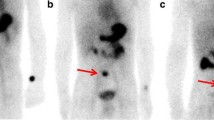Abstract
This case report illustrates the dynamic and static renal scintigraphic images of a patient with an unusual large diverticulum of the renal pelvis. The initial diagnosis by intravenous pyelography (IVP) and ultrasonographic (US) examination was a renal pelvic diverticulum of the left kidney, and the patient was referred to the nuclear medicine department for exploration of the effect of the pelvic diverticulum on renal functions.
We performed dynamic renal scintigraphy with technetium-99m (Tc-99m) labeled mercapto-acetyl triglycine (MAG-3) and static renal scintigraphy with Tc-99m labeled dimercaptosuc-cinic acid (DMSA). In dynamic renal scintigraphy, bilaterally normal concentration function was observed. While right kidney excretion function was normal, an incomplete excretion pattern was seen on the left side. Complete urinary flow obstruction occurred approximately at the 10th minute of the acquisition, which did not seem to respond to the i.v. furosemide application. However, when only the renal cortex was included in the region of interest, the obstructive pattern disappeared. In static renal scintigraphy, a large renal pelvic diverticulum localized antero-medially was clearly visualized in the left-anterior oblique projection, most probably due to accumulation of radiopharmaceutical inside it.
This case showed that a renal pelvic diverticulum should be thought of when an incomplete excretion pattern is seen on dynamic renal scintigraphy. Using only a cortical region of interest may also help to distinguish other types of obstructive pattern from diverticulum. Additionally, Tc-99m DMSA scintigraphy may show diverticulum localization with antero-oblique projections in addition to routine projections.
Similar content being viewed by others
References
Middleton A, Pfister RC. Stone-containing pyelocaliceal diverticulum: embryogenic anatomic, radiologic and clinical characteristics.J Urol 1974; 111:2–6.
Siegel MJ, McAlister WH. Calyceal diverticula in children: unusual features and complications.Radiology 1979; 131:79–82.
Timmons JW Jr, Malek RS, Hattery RR, Deweerd JH. Caliceal Diverticulum.J Urol 1975; 114:6–9.
Auge B K, Munver R, Kourambas J, Newman GE, Preminger GM. Endoscopie management of symptomatic caliceal diverticula: a retrospective comparison of percutaneous nephrolithotripsy and ureteroscopy.J Endourol 2002; 16:557–563.
Torrecilla Ortiz C, Marco Perez L, Contreras Garcia J, Ponce Campuzano A, Ruiz-Lluch Lopez R, Roig Sanz M, et al. Role of electrohydraulic extracorporeal Shockwave lithotripsy (Dornier HM 4) in the treatment of caliceal diverticulum lithiasis.Actas Urol Esp 1998; 22:744–750.
Landry JL, Colombel M, Rouviere O, Lezrek M, Gelet A, ubernard JM, et al. Long term results of percutaneous treatment of caliceal diverticular calculi.Eur Urol 2002; 41: 474–477.
Gluckman GR, Stoller M, Irby P. Laparoscopic pyelocaliceal diverticula ablation.J Endourol 1993; 7:315–317.
DeMarco RT, Cain MP, Davis MM. Xanthogranulomatous pyelonephritis associated with a congenital caliceal diverticulum.Urology 2001; 57: 168iii-168v.
Kavukcu S, Cakmakci H, Babayigit A. Diagnosis of caliceal diverticulum in two pediatrie patients: A comparison of sonography, CT and urography.J Clin Ultrasound 2003; 31:218–221.
Wogan JM. Pyelocaliceal diverticulum: an unusual cause of acute renal colic.J Emerg Med 2002; 23:19–21.
Chesa Ponce N. Pyelocaliceal diverticuli.Actas Urol Esp 1997; 21:180–186.
Fortunelli D, Gamuzza F, Bisacci R. Diverticula of the renal calyx and pelvis (presentation of an unusual case of giant diverticulum of the pelvis associated with multiple intra- diverticular lithiasis).Acta Chir Ital 1969; 25:35–63.
Zanollo A, Bono AV, Landini A. Diverticulosis of the renal calices and pelvis.Minerva Urol 1968; 20:51–63.
Author information
Authors and Affiliations
Corresponding author
Rights and permissions
About this article
Cite this article
Turgut, B., Erselcan, T., Ozdemir, S. et al. A large renal pelvic diverticulum, presenting incomplete excretion during tc-99m mag-3 scintigraphy and tracer accumulation on tc-99m dmsa scintigraphy; a case report. Ann Nucl Med 18, 689–693 (2004). https://doi.org/10.1007/BF02985963
Received:
Accepted:
Issue Date:
DOI: https://doi.org/10.1007/BF02985963




